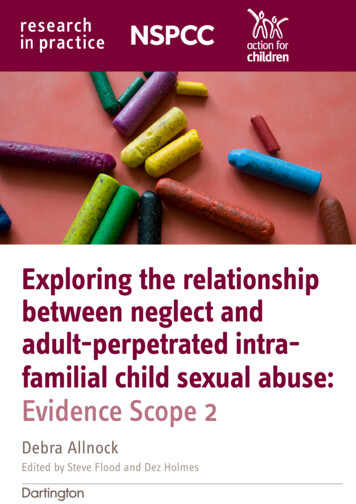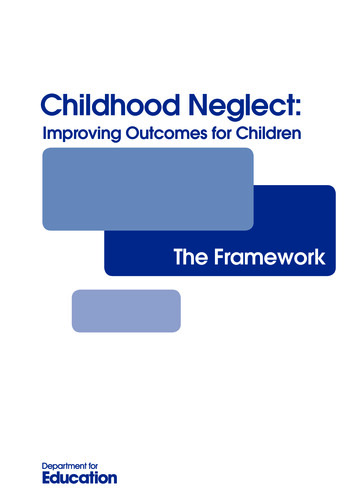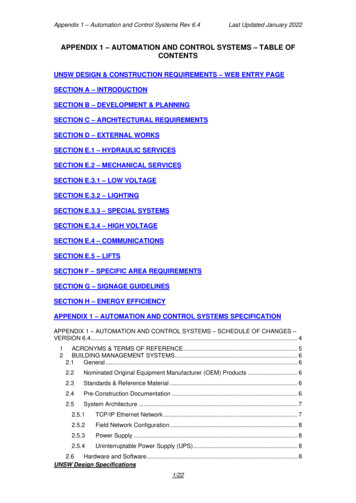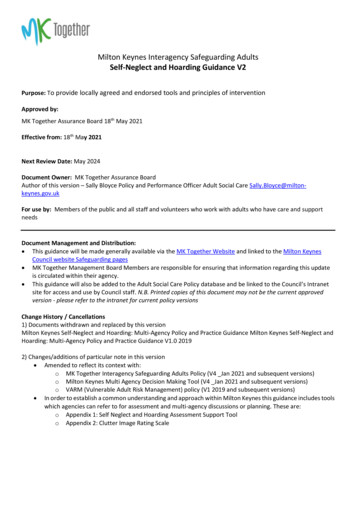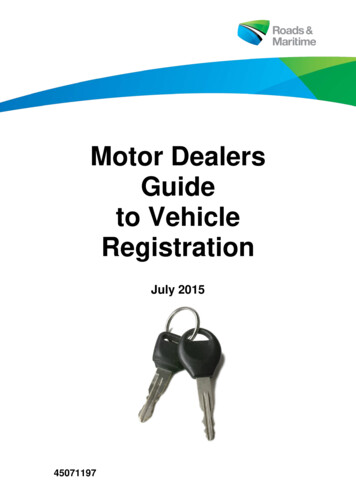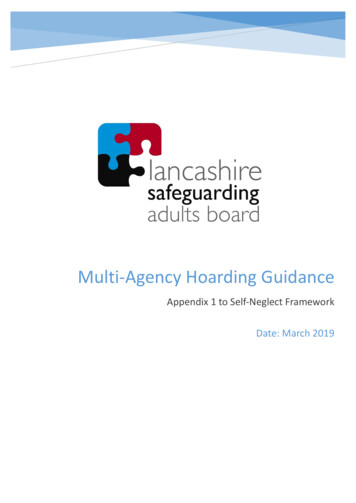
Transcription
Multi-Agency Hoarding GuidanceAppendix 1 to Self-Neglect FrameworkDate: March 2019
Information SheetTitleLancashire Safeguarding Adults Board (LSAB) Multi-agencyHoarding GuidanceRatified ByLSAB BoardRatification/Publication DateMarch 2019Review DateIn line with Self Neglect FrameworkVersion UpdatesVersion 1Responsible GroupLancashire Safeguarding Adults Board, Policies & ProceduresSub-GroupAcknowledgementLiverpool City Council Safeguarding TeamPlease note that the website version of this document is the only version that is maintained. Any printedversions should therefore be viewed as ‘uncontrollable’ and may not be the most up-to-date.1
Contents1. Introduction . 32. Aims of this Guidance . 33. Types of Hoarding . 34. General Characteristics of Hoarding . 35. Detection and Associated Issues. 56. Mental Capacity . 57. Mental Health Disorder . 78. Information Sharing . 79. Fire Safety. 710. Housing Support . 811. Safeguarding Children . 812. Safeguarding Adults . 813. Assessment and Reporting Hoarding . 9Appendix A. Legal Intervention and Enforcement Measures . 13Appendix B. Clutter Image Rating Tool Guidance . 17Appendix C. Assessment Tool Guidance . 20Appendix D. Practitioner’s Hoarding Assessment. 29Appendix E. Useful Contacts and References . 312
1. IntroductionThe purpose of this document is to set out the protocol and process for organisations which may come acrossa resident in Lancashire who hoards. It sets out a framework for collaborative multi-agency working using aperson centred approach in order to fully achieve the best outcome for the individual whilst meeting therequirements and duties of the Care Act 2014.2. Aims of this GuidanceThe aims of this Guidance are to: Create a safer and healthier environment for the individual and others affected by the hoardingbehaviour, e.g. family and neighbours Develop a multi-agency pathway which will maximise the use of existing services and resources whichmay reduce the need for compulsory solutions Ensure that when solutions are required, there is a process for planning solutions tailored to meet theneeds of the individual and utilising a person centred approach. Possible solutions should includeprofessional support and monitoring, property repairs and permanent or temporary re-housing Develop creative ways of engaging individuals in the process Establish best practice and improve knowledge of legislation that relates to hoarding behaviour3. Types of HoardingThere are typically three types of hoarding: Inanimate objects: This is the most common. This could consist of one type of object or collection ofa mixture of objects, such as old clothes, newspapers, food, containers or papers Animal hoarding: This is on the increase and often accompanied with the inability to provide minimalstandards of care. The hoarder is unable to recognise that the animals are at risk because they feelthey are saving them. The homes of animal hoarders are often eventually destroyed by theaccumulation of animal faeces and infestation by insects Data Hoarding: This is a relatively new phenomenon. It could present with the storage of datacollection equipment such as computers, electronic storage devices or paper. A need to store copiesof emails, and other information in an electronic format4. General Characteristics of Hoarding Fear and anxiety: compulsive hoarding may have started as a learnt behaviour or following asignificant event such as bereavement. The person who is hoarding believes buying or saving thingswill relieve the anxiety and fear they feel. The hoarding effectively becomes their comfort blanket3
Any attempt to discard the hoarded items can induce feelings varying from mild anxiety to a full panicattack with sweats and palpitations Long term behaviour pattern: possibly developed over many years or decades of ‘buy and drop’.Collecting and saving with an inability to throw away items without experiencing fear and anxiety Excessive attachment to possessions: people who hoard may hold an inappropriate emotionalattachment to items Indecisiveness: people who hoard may struggle with the decision to discard items that are no longernecessary, including rubbish Unrelenting standards: people who hoard will often find faults with others; requiring others to performto excellence while struggling to organise themselves and complete daily living tasks Socially isolated: people who hoard will typically alienate family and friends and may be embarrassedto have visitors. They may refuse home visits from professionals, in favour of office basedappointments Large number of pets: people who hoard may have a large number of animals that can be a sourceof complaints by neighbours. They may be a self-confessed ‘rescuer of strays’ Mentally competent: people who hoard are typically able to make decisions that are not related tohoarding Extreme Clutter: hoarding behaviour may be in a few or all rooms and prevent them from being usedfor their intended purpose Churning: hoarding behaviour can involve moving items from one part of the property to another,without ever discarding them Self-care: a person who hoards may appear unkempt and dishevelled, due to lack of bathroom orwashing facilities in their home. However, some people who hoard will use public facilities in order tomaintain their personal hygiene and appearance Poor insight: a person who hoards will typically see nothing wrong with their behaviours and theimpact it has on them and others Avoidance: a person will avoid many tasks, avoid people, avoid scenarios that may make them feelextremely anxious – Avoidance is the main area that stops hoarding making changesHowever many hoarders may be well-presented to the outside world, appearing to cope with other aspectsof their life quite well, and giving no indications of what is going on behind closed doors.Health implications can include: Living in squalid conditions, infestations and associated diseases Limited cooking, bathing, heating, sometimes without connected utilities Self-neglect, leading to other medical complications Lack of mental capacity leading to unwise decisions making Anxiety and depression Serious risk to life, for example risk of fire and contamination4
5. Detection and Associated IssuesSome issues may be identified by:Access Issues Gaining access – as this is generally not welcomed Repairs or debt issues triggered by reactive visit Gas checks and necessary repairs – e.g. leaks into neighbouring properties – do contactors knowwhen appropriate to report an issueNeighbours, friends and relatives Smell or obvious pest problem – usually when it comes noticeable in neighbouring properties Concerned neighbours or complaint Items creeping into communal areas or outdoor space, overgrown gardens, and Concerned friends and family may make a report to partnersUn-scheduled/scheduled Visits Welcome visits/tenancy checks (indicates early on if potential problem) Periodic occupancy checks (home visit not by phone) GP, Fire or ambulance service –tends to be crisis point such as hospitalisation Meals on wheels or other domestic/carer/safety/occupational therapist visits Social worker/housing support worker Responsive visit e.g. repairsGeneral Information from previous landlord Case notes/handover between teams and sometimes between landlords6. Mental CapacityThe Mental Capacity Act (MCA) 2005 provides a statutory framework for people who lack the capacity tomake decisions by themselves. Professionals are required to pay regard to the MCA. The Act has fivestatutory principles and these are legal requirements of the Act:1. A person must be assumed to have capacity unless it is established that they lack capacity2. A person is not to be treated as unable to make a decision unless all practicable steps have beentaken without success5
3. A person is not to be treated as unable to make a decision merely because he/she makes an unwisedecision4. An act done, or decision made, under this act for, or on behalf of, a person who lacks capacity mustbe done, or made in his or her best interests5. Before the act is done, or the decision is made, regard must be had to whether the purpose for whichit is needed can be as effectively achieved in a way that is less restrictive of the person’s rights andfreedom of actionA person may lack capacity if at the time they are unable to make a decision for themselves in relation to thematter, because of an impairment or disturbance that is permanent or temporary.When a person’s hoarding behaviour poses a serious risk to their health and safety, professional interventionwill be required. Emergency first responders will need to make time-specific decisions, based upon the factspresented and the urgency of the risks to individuals, in line with legislation and their organisation's ownprotocols. On the occasion that officers are called to incidents of an individual requiring support and wherehigh risk hoarding is identified, they will make decisions as to the immediate safeguarding requirements,based upon the vulnerability of the individual presented at that time. They will respond appropriately in thatmoment and refer to other agencies for support and further assistance, as required, which may include formalassessments in relation to whether an individual has capacity to make specific decisions regarding theirhoarding behaviour.With the exception of statutory requirements, the intervention or action proposed must be with the individual’sconsent. Article 8 of the European Convention on Human Rights (The right to respect for private and familylife) - is engaged. Interference with a person’s life must be lawful, necessary and pursue a legitimate aim.In extreme cases, taking statutory principle 3 (above) into account, the very nature of the environment maylead the professional to question whether the adult has capacity to consent to the proposed action orintervention and trigger a capacity decision-specific assessment, which should be recorded appropriately. Allinterventions must be undertaken in accordance with the 5 statutory principles and using the ‘two stage’ testof capacity (see MCA Code of Practice 4.11 – 4.25).The MCA Code of Practice states that one of the reasons why people may question a person’s capacity tomake a specific decision is that “the person’s behaviour or circumstances cause doubt as to whether theyhave capacity to make a decision” (MCA Code of Practice, 4.35). Extreme hoarding behaviour may thereforein the specific circumstances of the case, prompt an assessment of capacity.If it is decided that action needs to be taken without the consent of the adult, a full exploration of the legaloptions should be explored (See appendix A), identifying the risks and benefits of each option. Given thecomplex and diverse nature of self-neglect and hoarding, responses by a range of organisations are likely tobe more effective than a single agency response.6
7. Mental Health DisorderHoarding Disorder is recognised as a mental health condition in the Diagnostic & Statistical Manual (DSMV), and it should be included as a mental health condition in its own right in the next edition of ICD-11(International Classification of Diseases) published by the World Health Organisation, this next edition is dueout in 2018.8. Information SharingPractitioners must always seek the consent of the adult at the heart of the concern before taking action orsharing information. However there may be circumstances when consent cannot be obtained because theadult lacks the capacity to give it but the best interests of the individual or others at risk of harm demandaction. In these cases Mental Capacity Act guidance should be followed.In some cases, where an adult refuses consent, information can still lawfully be shared if it is in the publicinterest to do so. This may include protecting someone from serious harm or preventing crime and disorder.The key factors in deciding whether or not to share confidential information are: Necessity – sharing is likely to make an effective contribution to preventing the risk, and; Proportionality – the public interest in sharing outweighs the interest in maintaining confidentialityIf there is any doubt about whether to share information, advice should be obtained from your organisationsgovernance lead. Things to consider are: Adequate recording if the consent of the adult was obtained and if not why not What information was shared and with whom and how the request was received and recorded, andhow the decision was made to share the information If third party information is involved if consent was obtained and if not which exemptions applied All agencies involved must follow the appropriate statutes and guidanceUnder the General Data Protection Regulation (GDPR), organisations have the responsibility to ensure thatpersonal information is processed lawfully and fairly. All adults have a right to view any information heldabout them. Practitioners should consider this when they are recording information about the adult.9. Fire SafetyHoarding increases the risk of a fire occurring and makes it more difficult for people living within the propertyto evacuate safely. Fire can also spread to neighbouring properties if the level of hoarding is severe or ifflammable items such as gas containers are being stored. It also poses a high risk to fire fighters whenattending the scene.7
The sharing of information is extremely important for operational firefighter crew safety. Lancashire Fire andRescue Service is required to be compliant with the Fire Services Act, 2004, Regulation 7.2d to makearrangements for obtaining information needed for the purpose of extinguishing fires and protecting life andproperty in their area. The multi-agency approach to sharing information about hoarding enables compliancewith the Act and also strengthens the operational risk assessment when dealing with incidents and fireswhere hoarding is present.10. Housing SupportLancashire housing associations and registered landlords can and do play an important role in supportingpeople who hoard. Tenancy support and housing officers can help build up a relationship with their tenantsin an effort to support people who are in need to avoid them losing their tenancy and becoming homeless.Tenancy support and housing officers have worked persistently and persuasively with some tenants to helpthem clear up their homes, often in combination with other services. Where a person may be hoarding andlives with a housing association property, the landlord should be contacted as soon as possible for a multiagency response.11. Safeguarding ChildrenSafeguarding Children refers to protecting children from maltreatment, preventing the impairment of theirhealth or development and ensuring that they are growing up in circumstances consistent with the provisionof safe and effective care. Growing up in a hoarding property can put a child at risk by affecting theirdevelopment and, in some cases, leading to the neglect of a child, which is a safeguarding issue.The needs of the child at risk must come first and any actions we take must reflect this. Where children livein the property, a Safeguarding Children alert should always be raised. Please refer to the following link forguidance or complete the Lancashire CSC referral urces/assessment-and-referral.aspx12. Safeguarding AdultsSafeguarding Adults means protecting an adult’s right to live in safety, free from abuse and neglect. It is aboutpeople and organisations working together to prevent, and stop, both the risks and experience of abuse orneglect, while at the same time making sure that the adult’s wellbeing is promoted including, whereappropriate, having regard to their views, wishes, feelings and beliefs in deciding on any action. This mustrecognise that adults sometimes have complex interpersonal relationships and may be ambivalent, unclearor unrealistic about their personal circumstances.Hoarding may become a reason to make safeguarding enquiries when: The level of hoard poses a serious health risk to the person or neighbours There is a high risk of fire or infestations by insects or animals8
Hoarding is connected with other concerns of self-neglect, such as neglect, physical health, lack ofadequate nutrition Hoarding may be linked to serious cognitive decline and lack of capacity to self-care and care for theenvironment Hoarding is threatening a person’s tenancy and they are at risk of being made homeless throughclosure orders or possession ordersIf in doubt, discuss the issue with a manager or complete the Lancashire Safeguarding Adults Alert shire-safeguarding-adults/13. Assessment and Reporting HoardingThe organisation who identifies the concerns about an adult hoarding should consider their role in supportingthe individual and what immediate action is required. Using the Clutter Image Ratings, knowledge of the caseand professional judgement should help you to gauge the seriousness of the hoarding and actions to beconsidered by the agency who has identified the concerns. Discuss your concerns with the individual andwith their consent and where appropriate make the necessary referral. Where you are unable to obtainconsent information can still lawfully be shared if it is in the public interest to do so and where it may protectsomeone from serious harm.Level 1 Minimal risk (Clutter Pictures 1-3) Lancashire Fire and Rescue Service for their home fire safety check service Consider referral to the GP if the adult appears to have low mood or is presenting with a physicalcondition that is affecting how they care for themselves and their home If the adult has care support needs that is having a significant effect on their wellbeing refer to AdultSocial Care 0300 123 6720 for an assessment of their needs Liaise with landlord if resident is a tenant Liaise with Environmental HealthLevel 2 Moderate risk (Clutter Pictures 4-6) Refer to landlord if resident is a tenant Refer to Environmental Health Raise a request to Lancashire Fire and Rescue for their Home Fire Safety Check service Provide details of garden services If the adult has care and supports needs that is having a significant effect on their wellbeing refer toadult social care for a care and support assessment Referral to GP to request a review of medical/psychological needs and impact of hoarding Referral to debt advice if appropriate Refer to animal welfare if there are animals at the property Ensure information sharing with all necessary statutory agencies9
Level 3 High/Critical Risk (Clutter Pictures 7-9) Raise safeguarding concern within 24 hours if there are care and support needs If the individual does not meet the safeguarding thresholds for a referral, consider contacting AdultSocial Care 0300 123 6720 regarding possible care and support needs assessment Raise a request to Lancashire Fire and Rescue Service within 24 hours to provide a Home Fire SafetyCheck Refer to Environmental Health13.1 Example questions to ask as part of an assessmentListed below are examples of questions you may wish to ask where you are concerned about someone’ssafety in their own home, where you suspect a risk of self-neglect and/or hoarding. Most adults with ahoarding problem will be embarrassed about their surroundings so try to ascertain information whilst beingas sensitive as possible How do you get in and out of your property? Do you feel safe living here? Have you ever had an accident, slipped, tripped up or fallen? How did it happen? How do you move safely around your home? (Where floor is uneven or covered or there are exposedwires, damp, rot or other hazards) Has a fire ever started by accident? Is the property at risk from fire? How do you get hot water, lighting and heating in the property? Do these services work properly?Have they ever been tested Do you ever use candles or an open flame to heat and light here or cook with camping gas? How do you manage to keep yourself warm? Especially in winter? When did you last go out in your garden? Do you feel safe to go out there? Are you worried about other people getting in to your garden to try and break-in? Has this everhappened? Are you worried about mice, rats or foxes, or other pests? Do you leave food out for them? Have youever seen mice or rats in your home? Have they eaten any of your food? Or got upstairs and benesting anywhere? Can you prepare food, cook and wash up in your kitchen? Do you use your fridge? Can I have look in it? How do you keep things cold in the hot weather? How do you keep yourself clean? Can I see your bathroom? Are you able to use your bathroom anduse the toilet ok? Have a wash, bath? Shower? Can you show me where you sleep and let me see your upstairs rooms? Are the stairs safe to walkup? (if there are any) What do you do with your dirty washing?10
Where do you sleep? Are you able to change your bed linen regularly? When did you last changethem? How do you keep yourself warm at night? Have you got extra coverings to put on your bed if you arecold? Are there any broken windows in your home? Any repairs that need to be done? Because of the number of possessions you have, do you find it difficult to use some of your rooms?If so which ones? Do you struggle with discarding things or to what extent do you have difficulty discarding (or recycling,selling, giving away) ordinary things that other people would get rid of?13.2 A multi-agency response to hoardingIt is recognised that hoarding is a complex condition and it has becomes increasingly evident that a shortterm case management approach to people who hoard to a critical level is unlikely to be successful. Itrequires practitioners to build up trust with the adult in order for the adult to acknowledge there is an issuewith their hoarding and the associated risks.A multi-agency approach may be needed to explore options for encouraging engagement. Various agenciesmay have information about the adult and some may have established a relationship with them. A multiagency meeting to share information and decisions about how best to intervene may need to be called. Themeeting should consider the level and aspects of risk and ways in which agencies can contribute to managingthe risk alongside the adult.13.3 Responses to hoarding may include: If the person has capacity to make decisions about seeking help, then a referral, with their agreement,for psychological therapy or CBT would be indicated Working with the person over time to support them in clearing their hoard. It may involve targetedwork with the person on a plan to gradually clear the hoard and supporting them to do this If the person lives in rented accommodation, they may need support in liaising with the landlord if theyare threatened with eviction The person may need support in liaising with environmental or pest control departments With their agreement referral to the Fire Service for a preventative fire risk assessment If the person lacks capacity with regard to managing their environment, then they may need ongoingsupport with self-care and managing their domestic routine Careful assessment of capacity and a needs assessment is therefore important to establish how bestand on what basis to intervene When a person has capacity then it is important to work with them and to understand their wishes andfeelings. If the person lacks capacity to make relevant decisions best interest decision making maybe necessary whilst still taking into account the person’s wishes as far as these can be ascertained11
The lead agency involved with the adult may consider calling a multi-agency meeting to discuss aplan for interventionThe agencies who may be best placed to support people who self-neglect may be one or a combination of: Mental health services accessed via the GP Voluntary services to provide advocacy and practical support Housing tenancy support officers Environmental services Fire services Social work safeguarding enquiries, needs assessment and care planning, ongoing support andintervention Advocacy services13.4 Working with adults who hoard and are at risk of harmPractitioners should not automatically accept an initial refusal to engage with services as an unwise decisionwhere it involves an adult at risk of harm due to hoarding. Contact should be maintained to build up trust andundertake an assessment of capacity over several visits. Sometimes an adult may present really well initiallybut further assessment of their capacity reveal that the person has no insight into the risk of harm tothemselves or others.When faced with constant refusal where the adult is at risk of serious harm the practitioner should considercalling a safeguarding strategy meeting and consider inviting the following agencies: Local Authority Legal Services GP or named GP for safeguarding adults if adult not registered with a GP Mental Health Professional or if not known to services Lancashire NHS Safeguarding Lead Registered Social Landlord if relevant Environment Health Family Member Independent Mental Capacity Advocate/Care Act AdvocateThe purpose of the safeguarding strategy meeting is to assess the risk to the adult, decide if any furtheraction is required, establish roles and responsibilities, decide which agency should take the lead and developsafeguard plans.All information must recorded in the adult’s case notes for each agency, ensuring appropriate informationthat can be shared is done so at the strategy meeting.12
13.5 Adult with capacity refuses to engage with servicesIf it is deemed that the person has capacity and does not have a mental disorder, as defined under TheMental Health Act, that requires assessment or treatment and the adult continues to refuse services, thepractitioner should complete their organisation’s own risk assessment and agree who is best placed tomonitor the individual and periodically offer support for an agreed period of time. The case must not be closedwithout the approval of their manager and all information must be recorded in the adult’s case notes.Appendix A. Legal Intervention and Enforcement MeasuresCare Act 2014The Care Act 2014 builds on recent reviews and reforms, replacing numerous previous laws, to provide acoherent approach to adult social care in England. Local authorities (and their partners, housing, welfare andemployment services) must now take steps to prevent, reduce or delay the need for care and support for alllocal people.Section 42 Care ActThe Care Act 2014 sets a clear framework for how local authorities should protect adults at risk of abuse orneglect. The Act places a duty on local authorities to make enquiries, or cause others to do so, if it believesthat an adult: has needs for care and support (whether or not the authority is meeting those needs) and; is experiencing, or is at risk of, abuse or neglect, and; as a result of those needs is unable to protect himself or herself against the abuse or theneglect or the risk of itCare Act 2014 Statutory GuidanceThe Care Act statutory guidance was revised in March 2016 Chapter 14.17 states that self-neglect covers awide range of behaviour neglecting to care for one’s personal hygiene, health or surroundings and includesbehaviour such as hoarding. It should be noted that self-neglect may not prompt a section 42 enquiry. Anassessment should be made on a case by case basis. A decision on whether a response is required undersafeguarding will depend on the adult’s ability to protect themselves by controlling their own behaviour. Theremay come a point when they are no longer able to do this, without external support.Mental Capacity Act 2005If the person has been assessed as lacking capacity in relation to a matter relating to their welfare the Courtof Protection has the power to make an order under Section 16(2) of the Mental Capacity Act, which makes13
the decision on the person’s behalf to allow access to an adult lacking capacity. The court can also appointa deputy to make welfare decisions for that person.Mental Health Act 1983If a mentally ill person is not receiving proper care, Section 115 of the Mental Health Act 1983 allows anapproved mental health professional (AMHP) to enter and inspect any premises where the person is living.Entry of force is not permitted and there is no power to remove the person.Under Section 135 (1) of the Act an AMHP can make an application to a Magistrate for a warrant authorisinga police officer to enter, if necessary by force, any premises specified in the warrant if
4. General Characteristics of Hoarding Fear and anxiety: compulsive hoarding may have started as a learnt behaviour or following a significant event such as bereavement. The person who is hoarding believes buying or saving things will relieve the anxiety and fear they feel. The hoarding effectively becomes their comfort blanket
